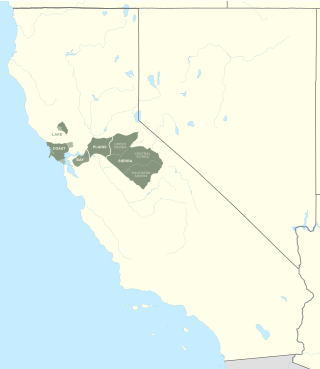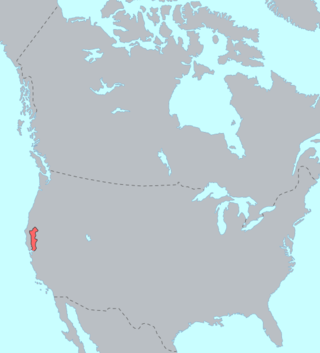
The Miwok are members of four linguistically related Native American groups Indigenous to what is now Northern California, who traditionally spoke one of the Miwok languages in the Utian family. The word Miwok means people in the Miwok languages.

The Wintu are Native Americans who live in what is now Northern California. They are part of a loose association of peoples known collectively as the Wintun. There are three major groups that make up the Wintu speaking people. The Wintu, Nomlaki, and Patwin. The Wintu language is part of the Penutian language family.

The Wintun are members of several related Native American peoples of Northern California, including the Wintu (northern), Nomlaki (central), and Patwin (southern). Their range is from approximately present-day Lake Shasta to San Francisco Bay, along the western side of the Sacramento River to the Coast Range. Each of these tribes speak one of the Wintuan languages. Linguistic and archaeological evidence suggests that the Wintun people probably entered the California area around 500 AD from what is now southern Oregon, introducing bow and arrow technology to the region. There has been carbon dating of several artifacts by UC Berkeley that dates back to around 10,000 years, and several of these artifacts have now been repatriated. Despite being a major influence on the region's history, there is still very little history on the Wintu due to centuries of genocide and displacement that still occur today along with continued destruction of sacred ceremonial and religious sites, often due to companies that ignore legal or ethical considerations.

The Maidu are a Native American people of northern California. They reside in the central Sierra Nevada, in the watershed area of the Feather and American Rivers and in Humbug Valley. In Maiduan languages, maidu means "man".

Wintuan is a family of languages spoken in the Sacramento Valley of central Northern California.

The Patwin are a band of Wintun people in Northern California. The Patwin comprise the southern branch of the Wintun group, native inhabitants of California since approximately 500.
The Tolowa people or Taa-laa-wa Dee-ni’ are a Native American people of the Athabaskan-speaking ethno-linguistic group. Two rancherías still reside in their traditional territory in northwestern California. Those removed to the Siletz Reservation in Oregon are located there.
Paskenta is a small unincorporated town in Tehama County, California. Historically, it had greater local importance due to the presence of an active lumber mill. The ZIP Code is 96074. The community is inside area code 530 and the Paskenta CDP. Paskenta sits at an elevation of 725 feet (221 m). The 2010 United States census reported Paskenta's population was 112. Paskenta was originally inhabited by a tribe of Nomlaki people who are now part of the federally-recognized Paskenta Band of Nomlaki Indians.

The Yana are a group of Native Americans indigenous to Northern California in the central Sierra Nevada, on the western side of the range. Their lands, prior to encroachment by white settlers, bordered the Pit and Feather rivers. They were nearly destroyed during the California genocide in the latter half of the 19th century. The Central and Southern Yana continue to live in California as members of Redding Rancheria.

The Plains and Sierra Miwok were once the largest group of California Indian Miwok people, Indigenous to California. Their homeland included regions of the Sacramento Valley, San Joaquin Valley, and the Sierra Nevada.

Stephen Powers (1840–1904) was an American journalist, ethnographer, and historian of Native American tribes in California. He traveled extensively to study and learn about their cultures, and wrote notable accounts of them. His articles were first published over a series of years in the Overland Monthly journal, but collected in The Tribes of California (1877) published by the US Geological Survey.
Wintu-Nomlaki traditional narratives include myths, legends, tales, and oral histories preserved by the Wintu and Nomlaki people of the western Sacramento Valley in northern California.
Yuki traditional narratives include myths, legends, tales, and oral histories preserved by the Yuki people of the upper Eel River area of northwestern California.

The Kletsel Dehe Wintun Nation of the Cortina Rancheria is a federally recognized tribe of Indigenous people of California. They are Wintun people, who historically spoke Wintuan languages.
The Cachil DeHe Band of Wintun Native Americans of the Colusa Native Americans Community of the Colusa Rancheria is a federally recognized tribe of Wintun Native Americans from central California.
The Grindstone Indian Rancheria of Wintun-Wailaki Indians is a federally recognized tribe and ranchería of Wintun and Wailaki Indians from northern California. As of the 2010 Census the population was 164.
Nomlaki (Noamlakee), or Wintun, is a moribund Wintuan language of Northern California. It was not extensively documented, however, some recordings exist of speaker Andrew Freeman and Sylvester Simmons. There is at least one partial speaker left.
Patwin (Patween) is a critically endangered Wintuan language of Northern California. As of 2021, there was one documented first language speaker of Patwin. As of 2010, Patwin language classes were taught at the Yocha Dehe Wintun Nation tribal school.
The Yocha Dehe Wintun Nation is a federally recognized tribe of Wintun people, specifically Patwin people or southern Wintun, in Yolo County, California. They were formerly known as the Rumsey Indian Rancheria of Wintun Indians of California.

The Paskenta Band of Nomlaki Indians, or in their own language Nomlāqa Bōda, is a federally recognized tribe of Nomlaki people. The Nomlaki are Central Wintun, or River and Hill Nomlaki, an indigenous people of California, located in Tehama and Glenn counties.









